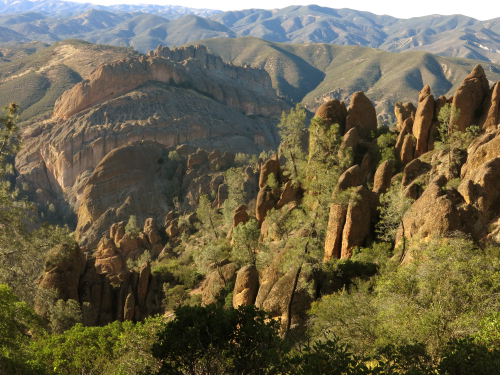
The Balconies, from the High Peaks Trail, Pinnacles National Park.
(For what it’s worth, Pinnacles was filled with families with children this week; both the camp ground and the trails appear to be kid-friendly.)
Yet Another Unitarian Universalist
A postmodern heretic's spiritual journey.

The Balconies, from the High Peaks Trail, Pinnacles National Park.
(For what it’s worth, Pinnacles was filled with families with children this week; both the camp ground and the trails appear to be kid-friendly.)
I took a break from curriculum development on Tuesday and drove down to Pinnacles National Park. Of course I looked at the incredible rock formations for which the park is famous. But as spectacular as the scenery was, the highlight of the trip was watching butterflies in Bear Gulch. In particular, I spent about ten minutes watching one Western Tiger Swallowtail visiting larkspur blossoms. I took a great many photographs of this one butterfly, getting as close as I could. With a photograph, you can capture narrow slices of time: the position the butterfly’s wings take as it balances on a flower; the way it clings to the flower with its legs and arches its head towards a blossom; the moment when the butterfly is just approaching the flower:
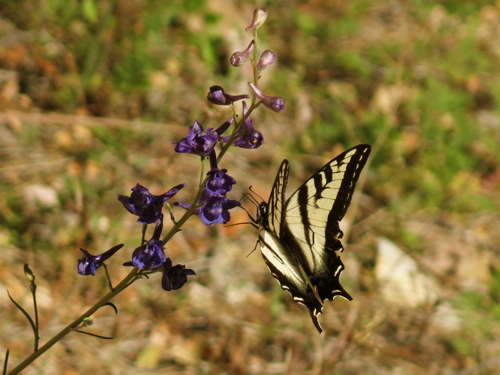
But sometimes what sticks in your memory is not what you actually saw, but the photographs of what you saw. After I left Pinnacles, I drove to Elkhorn Slough National Estuarine Research Reserve. When I saw butterflies there, I made a point of trying to sketch them in my field notebook rather than just photograph them, like this common butterfly:
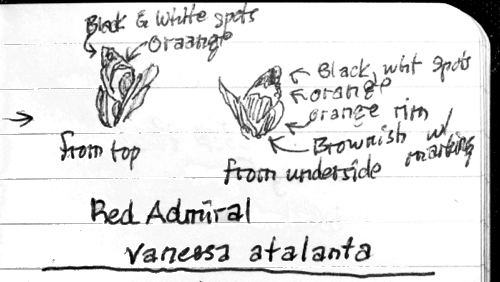
This sketch, as an end product, is not nearly as attractive as a photograph (and I did take a photograph of this insect as well) — it’s not as attractive, but I learned more about butterflies by making this sketch. By comparing my sketch to a field guide, by seeing what I left out, I learned what I don’t see when I look at butterflies. I suspect making less attractive sketches like this does more towards sharpening my powers of observation than does taking a great many very attractive photographs.
Carol and I decided to hike up to the top of Bald Knob from the parking lot at Higgins Canyon Road. We climbed steadily through the Coastal Redwoods up into the Douglas Fir forest, and in less than two hours were at the summit of Bald Knob. It was a little disappointing, because Bald Knob wasn’t at all bald, and instead of the views we had hoped for, we just had a Douglas Fir forest. But it was a beautiful Douglas Fir forest, smelling of fir trees and woods, and it was quiet, so we sat down to eat lunch.
After lunch, we walked down Irish Ridge Trail, and just a short distance down the trail, there were green grassy slopes sprinkled with wildflowers. Dad and I used to talk about the way wildflowers sprang up all over the hills of coastal California during the spring; it was one of the things that had most impressed him, I think, in one of his early trips to California. Unfortunately, Dad’s dementia means that that well-worn, familiar conversation is no longer possible, so I took a photograph of some flowers instead — Dad has always taken photographs documenting what he saw in the world; and still does, sometimes.
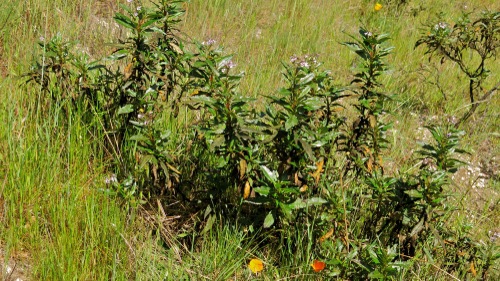
And a little way further down the trail were the views that we had hoped for. We looked out over an open slope, which was covered with Poison Oak in full bloom, down into the Lobitos Creek valley, out at the Pacific Ocean. Some kind of flower was sending its delightful perfume into the sun-warmed air around us; I’m pretty sure this perfume came from the Poison Oak; maybe Poison Oak is good for something after all.
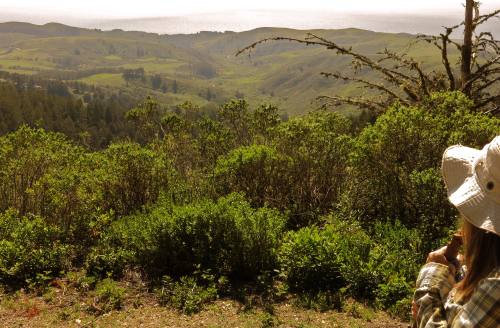
On the way back down the trail, Carol said that these tree roots, balanced precariously on a gradually eroding bank, looked like a huge Muppet monster:
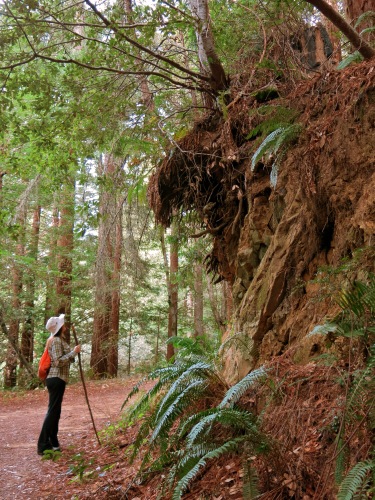
By the time we got back to the car, it was cloudy and cool, down to 52 degrees. We had walked about 11.4 miles, with a total elevation gain of about 2,500 feet. We felt kind of tired.
More and more, I’m coming to believe that if organized religion is going to help fix global climate weirdness, we have to get out of our buildings more. Not that we should get rid of our buildings — we need our indoor spaces to accommodate a wide range of human person, including elders. But we also need to do more outdoor ministries.
Last night, group of youth spent the night at the Black Mountain trail camp, in Santa Cruz Mountains behind Silicon Valley. The hike in is two miles, with a total elevation gain of about 500 feet. We got to the camp, set some tents and made dinner.
After dark, some of us took a quick walk up to the summit of Black Mountain (elev. 2,800 ft.) and looked down at the bright lights of San Jose and Silicon Valley on one side, and the mysterious fog creeping up the valley on the other side of the Santa Cruz Mountains. Come to think of it, that image could serve as a metaphor for the role of organized religion in understanding humans’ place in the universe: if we wanted it to, organized religion could be the metaphorical high point where we could see both human-centered life on one side, and non-human-centered life on the other side.
Back in camp, some of us slept in tents, and some of us just slept out under the stars. The moon was really bright, so I slept restlessly. I awakened before dawn, and snapped this photo of our campsite:
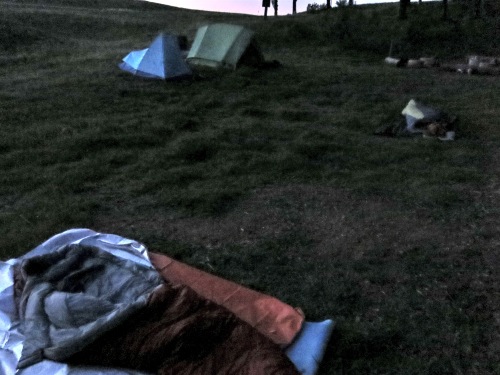
Dawn from the top of Black Mountain was beautiful: orange sky at the horizon and pink clouds above. After a breakfast of bacon hot chocolate, and more bacon, we hiked out, and were back in Silicon Valley by about ten. It was a short trip, but short trips fit in well with the busy schedules of our teens.
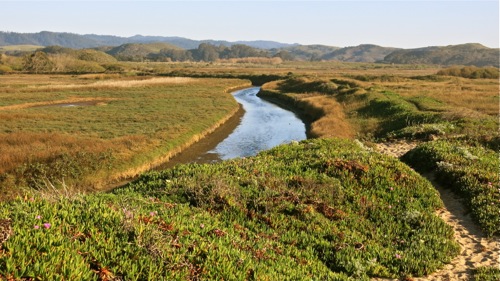
I went for a walk in Pescadero Marsh for the first time today. It’s a pretty remarkable place. It encompasses a variety of habitats, including pickleweed salt marsh, freshwater marsh, riparian corridor, sandy beach, old sand dunes, etc. Birdlife ranged from birds typical of beaches, like Sanderlings and Black Turnstones; to birds typical of freshwater marshes, like Marsh Wrens and Common Yellowthroats.
There were signs of other resident animals as well. Along the edge of Pescadero Creek, you pass by what look like big piles of sticks, but they’re actually houses built by Dusky-footed Wood Rats (Neotoma fuscipes). In the photo below, the tape measure at lower left is extended to 12 inches (300 cm); so this particular wood rat house is about four feet high (1.3 m).
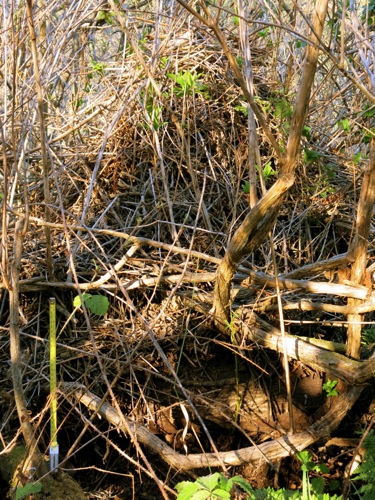
From a little further down the same trail, you can see a Great Blue Heron rookery. Their nests look like big piles of sticks, piles that may be three or more feet from bottom to top, that somehow got stuck high up in the branches of dead trees. I counted at least eight herons sitting on nests — four foot high birds roosting on three foot high piles of sticks thirty or forty feet above the ground.
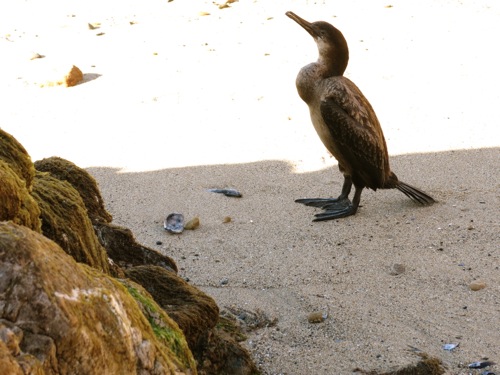
On a secluded part of the beach on the other side of Highway 1, an immature Double-crested Cormorant (Phalacrocorax auritus) was too stupid, or too dazed, to move away when I walked past it. It stood quite still while I took its photo (above). The other birds and animals I saw were far less trusting than this cormorant: as soon as humans came into view, they flew or scuttled away out of danger. Except for the fifty or so Elephant Seals I saw lying on the rocks out beyond the beach: they did not seem to pay any attention to the humans walking on the beach; but then, they were well out of reach of any meddling humans, protected by a couple hundred feet of surf and slippery rocks.
This afternoon I was walking in Purissima Creek Redwoods Open Space Preserve, through Douglas Fir woodlands, along a ridge that was about 1,400 feet aboe sea level. I happened to look down at my feet, and there was a — well, no, it wasn’t a lizard, it was some kind of salamander.
Sometimes it pays to walk slowly and deliberately. I got down on my knees to look more closely.
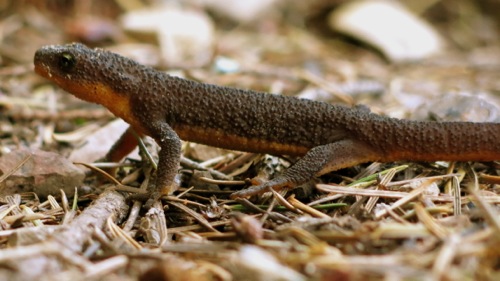
I haven’t seen seen a salamander since I moved to California more than five years ago, so I stopped to watch it for a while. I placed a quarter on the ground, to give a sense of scale in the photos I was taking. The salamander obligingly stepped right on the quarter:
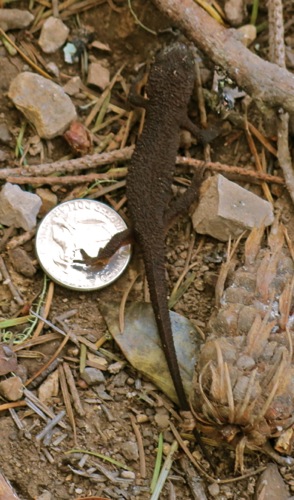
It was fun to watch it walk — it had that rolling, deliberate salamander gait, so very different from the quicker-than-the-eye sprinting done by lizards. Eventually, it walked off the trail and disappeared into the leaf litter.
When I got home, I looked on the California Herps online identification guide. I’m pretty sure it was a Rough-skinned Newt (Taricha granulosa). Another possibility would be the Red-bellied Newt (Taricha rivularis) — but the eye of my newt showed some whitish yellow, while T. Rivularis has uniformly dark eyes.
The middle school ecojustice Sunday school class got approval from the Board for installing a rain barrel at church. Last night, Buzz and I rushed to put a downspout from one of the roof drains into the rain barrel, in anticipation of today’s storm. It looks like our rushing was worth it: we’ve had over two and a half inches of rain since then.
I just took a little walk around our neighborhood. San Mateo Creek was filled with rushing brown water, but the water level is still ten to fifteen feet below the tops of the banks. The ground is pretty well saturated, and I could see puddles everywhere. But the storm drains are still working and the streets aren’t flooded around here. And I can see jetliners flying through the low clouds towards the airport, so it looks like SFO is open.
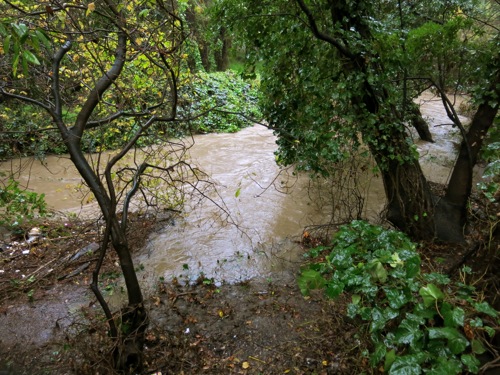
Above: San Mateo Creek at about 3:45 today, from the Delaware St. bridge. Those trees on the right are usually well out of the water.
But according the Twitter, other places around the Bay area are experiencing flooding. For example, Highway 101 south of San Francisco is flooded in places, and traffic is just a mess. I feel lucky that I was scheduled to work at home today.
A couple of years ago, Carol discovered the Really, Really Free Market which meets on the first Sunday of the month in Redwood City. The first time she went there, she got some rubber stamps and a couple of potted succulents which bloom at the tail end of the winter wet season. The plants produce small vividly pink flowers on astonishingly long stalks — the plant is all of ten inches high, the stalk extends twenty-four inches from the nearest leaf to the farthest blossom, and each blossom is an inch to an inch and a half in diameter. The flower in the photo is one of sixteen buds or blossoms or seed pods on one of the stalks. Each blossom seems to last a day or two before it fades, and then another bud near it comes into bloom.
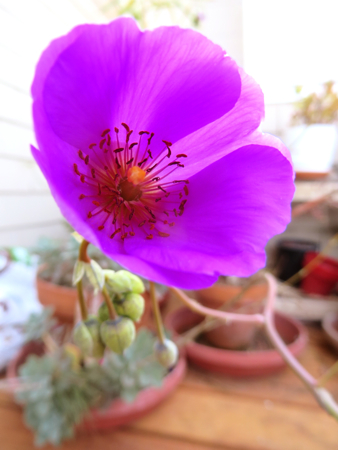
Today, the day after Mother’s Day, would have been my mother’s ninetieth birthday; I’m pretty sure the flower I photographed was in bloom yesterday, so its blooming will cover both these days.
The headlines on today’s newspaper screamed: “U.S.CLIMATE HAS ALREADY CHANGED, STUDY FINDS, CITING HEAT AND FLOODS” [New York Times, 7 May 2014, p. A1]. This is news because we didn’t already know what this report, the National Climate Assessment, is telling us. A related story tells us that “Polls Find Americans Skeptical On Climate” [ibid., p. A13]. And why? “Scientists predict that climate change will cause larger problems for poor countries than rich ones….” And the U.S. is way ahead of all other countries in per person emissions of climate-changing gasses.
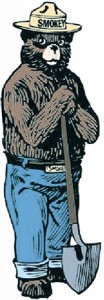 This is human nature: the ones who are causing the problem are least likely to be affected by the problem, so they believe they are not causing the problem. The minority of U.S. citizens who are aware of the magnitude of the problem attempt to convince other U.S. citizens of the truth with rational arguments, but since when did humans change their behavior as a result of rational argument?
This is human nature: the ones who are causing the problem are least likely to be affected by the problem, so they believe they are not causing the problem. The minority of U.S. citizens who are aware of the magnitude of the problem attempt to convince other U.S. citizens of the truth with rational arguments, but since when did humans change their behavior as a result of rational argument?
No, it is time to call on a higher power. One of the growing problems caused by climate change is the increased incidence of forest fires, and so we immediately know on whom we must call. We will follow the example set by poet Gary Snyder in 1969. Both Buddhists and non-Buddhists, both those who follow the circumpolar Bear cult and those who don’t, should call on the Boddhisattva of Compassion Avalokitesvara — who is also Kamui Kimun of the Ainu — who is also a consort of She Who Saves, Boddhisattva Tara, Mother of Liberation — who is he who carries the vajra-shovel.
Abandon rational argument, and chant together:
Smokey the Bear Sutra
Once in the Jurassic, about 150 million years ago, the Great Sun Buddha in this corner of the Infinite Void gave a Discourse to all the assembled elements and energies: to the standing beings, the walking beings, the flying beings, and the sitting beings—even grasses, to the number of thirteen billions, each one born from a seed—assembled there: a Discourse concerning Enlightenment on the planet Earth.
“In some future time, there will be a continent called America. It will have great centers of power called such as Pyramid Lake, Walden Pond, Mt. Rainier, Big Sur, Everglades, and so forth, and powerful nerves and channels such as Columbia River, Mississippi River, and Grand Canyon. The human race in that era will get into troubles all over its head, and practically wreck everything in spite of its own strong intelligent Buddha-nature.”
“The twisting strata of the great mountains and the pulsings of volcanoes are my love burning deep in the earth. My obstinate compassion is schist and basalt and granite, to be mountains, to bring down the rain. In that future American Era I shall enter a new form, to cure the world of loveless knowledge that seeks with blind hunger, and mindless rage eating food that will not fill it.”
And he showed himself in his true form of
SMOKEY THE BEAR.
Good photos of the ongoing Clifornia drought, and summary of long-range forecast possibilities, in a January 25 post at the California Weather Blog.
Here in San Mateo County, our drought level is classified as “extreme,” second highest of the five possible drought levels. The hills of the Coastal Range should be bright green right now, but instead they are dull gray-brown; needless to say, the fire danger is high. We haven’t had any significant rain in over a month, so the air is filled with fine particulate matter. And with a declared state-wide drought emergency, we’re all expecting mandatory water restrictions in the next few months.
On the plus side, we’ve had abnormally sunny and warm weather, with temperatures often in the seventies. while we need bad weather, at least we can enjoy the good weather while we’ve got it.